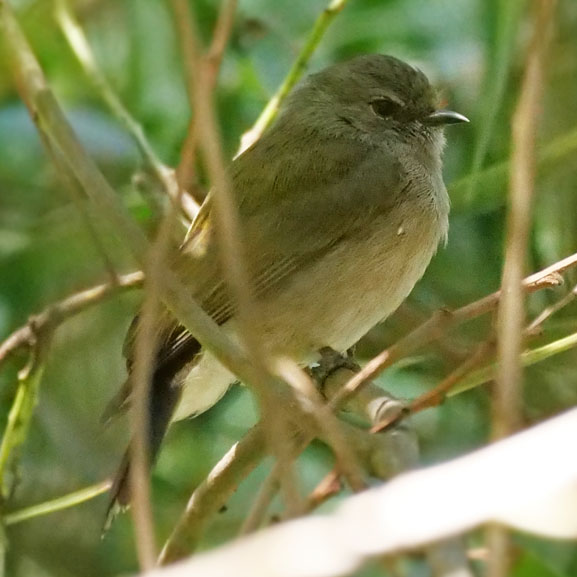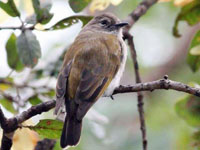The order Piciformes is made up of the woodpecker family Picidae plus 8 other families. Picidae make up about half of the species. In general, the Piciformes are insectivorous, but some exceptions eat mostly fruit. Nearly all Piciformes have parrot-like feet—two toes forward and two back, an arrangement that has obvious advantages for birds that spend much of their time on tree trunks. And most Piciformes do not have down feathers at any age, only true feathers. All nest in cavites.
Family Indicatoridae: Honeyguides
The honeyguides are found mainly in Africa, but some are also in Asia. One or two species deliberately lead humans directly to bee colonies, so that they can feast on the grubs and beeswax that are left behind. The guiding behavior leads to their name, Not only do most of the species feed on beeswax, some utilize other sources of wax such as waxworms or the waxy secretions of some scaly insects. They also eat insects and some fruit. Many of the species are adept at catching insects in the air and some even have a flycatcher appearance.
Most honeyguides are dull-colored, though some have bright yellow coloring in the plumage. All have light outer tail feathers, which are white in all the African species. Honeyguides are among the few birds that can digest wax. They vary from 10 to 20 cm in length and 10 to 55 grams in weight. The nesting behavior is not known for all the species, but the existing knowledge indicates that all lay their eggs in the next of other species, that is they are brood parasitic. Only one egg is put in each hosts next, and the deposits are often spread over varous species. Least you think this behavior is benevolent, both the parents and the baby honeyguides usually kill the other offspring that are in the nest.
Genus Indicator
Most of these honeyguides are found in Africa
Honeyguide,_Dwarf Indicator pumilio
Description: The dwarf honeyguide has green upperparts with some grey mixed in. It has a small white patch on the lores which helps distinguish it from other honeyguides. The underparts including the throat are greenish-grey. The dwarf honeyguide, as its name implies, is a small honeyguide with a length of 12 cm amd weight of about 13 grams.
Range: Eastern DR Congo, western Rwanda, western Burundi, and southwestern Uganda.
Habitat: Mountain forests, their edges and clearings.
Diet: Flies, other insects, beeswax.
Conservation status: It is listed as Near Threatened because of its restricted range and habitat degradation.
Image by: 1, 2) Nik_Borrow - UgandaRange: Eastern DR Congo, western Rwanda, western Burundi, and southwestern Uganda.
Habitat: Mountain forests, their edges and clearings.
Diet: Flies, other insects, beeswax.
Conservation status: It is listed as Near Threatened because of its restricted range and habitat degradation.
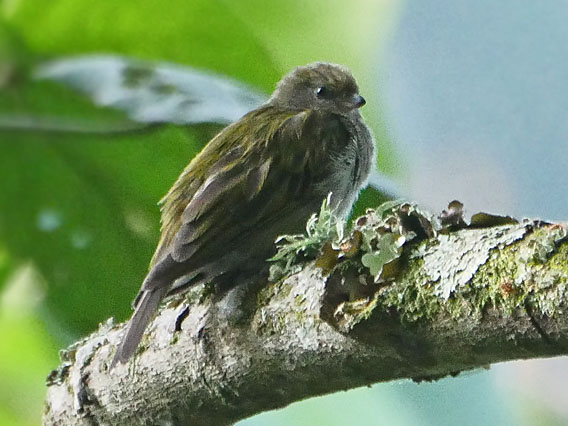
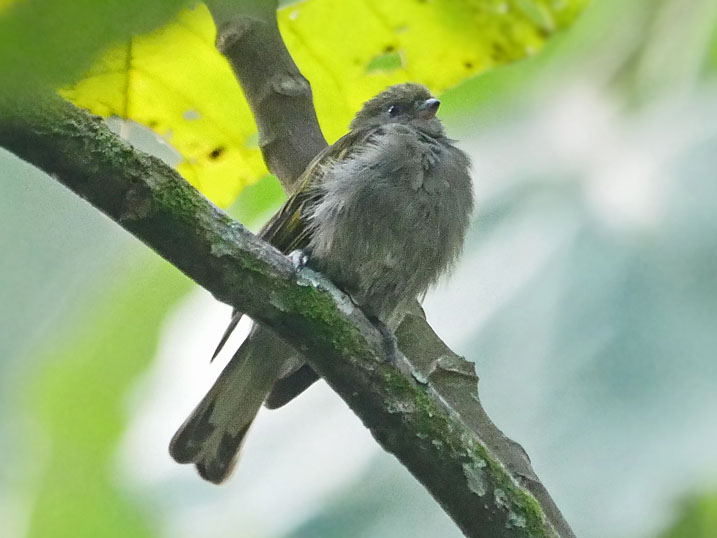
Honeyguide,_Greater Indicator indicator
Description: The greater honeyguide has bold white patches on the side of the tail. It has grey-brown upperparts, yellowish-white underparts, and a pink bill. The male has a black throat and a black face with a white ear-covert patch. The female has a black throat and grey face. The greater honeyguide is about 20 cm long and 50 grams in weight.
Range: Sub-Saharan Africa.
Habitat: Open woodlands, brushes and gardens with trees available.
Diet: Beeswax and their eggs plus larvae. Also flying insects such as termites, winged ants, flies. Sometimes leads humans to bee's nest so it can get the dregs after the humans leave. Lays its eggs in a wide variety of host nests.
Conservation status: Least Concern.
Image by: 1) Allan Hopkins - Gambia 2) Lohman-Braun - Gambia 3) Wilferd DuckittRange: Sub-Saharan Africa.
Habitat: Open woodlands, brushes and gardens with trees available.
Diet: Beeswax and their eggs plus larvae. Also flying insects such as termites, winged ants, flies. Sometimes leads humans to bee's nest so it can get the dregs after the humans leave. Lays its eggs in a wide variety of host nests.
Conservation status: Least Concern.
1) Juvenile 2) Female 3) Male


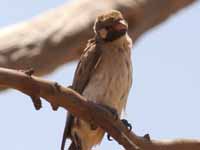
Honeyguide,_Least Indicator exilis
Description: The least honeyguide has dark greenish-brown upperparts. The head is darker with a white loral stipe and black malar stipe. The underparts are light greyish-green. The dark tail has white out-tail feathers with black tips. The least honeyguide is 14 cm long.
Range: Central Africa.
Habitat: Forest edges and clearings, treed grasslands.
Diet: Beeswax and their eggs plus larvae. Also grasshoppers, caterpillars, ants, termites.
Conservation status: Least Concern.
Image by: 1) Nik Borrow - GhanaRange: Central Africa.
Habitat: Forest edges and clearings, treed grasslands.
Diet: Beeswax and their eggs plus larvae. Also grasshoppers, caterpillars, ants, termites.
Conservation status: Least Concern.
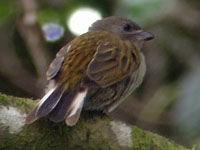
Honeyguide,_Lesser Indicator minor
Description: The lesser honeyguide has greyish-green upperparts and paler greyish-green underparts. It has a small white loral area which can continue and meet above the bill. The lesser-honeyguide is 14 to 16 cm long.
Range: Central and southern Africa.
Habitat: Forests, treed grassland, gardens.
Diet: Beeswax, ants, caterpillars, termites.
Conservation status: Least Concern.
Image by: 1) Alan Manson 2) Ian White - Botswana 3) Derek Keats - South AfricaRange: Central and southern Africa.
Habitat: Forests, treed grassland, gardens.
Diet: Beeswax, ants, caterpillars, termites.
Conservation status: Least Concern.
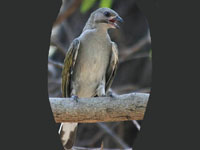
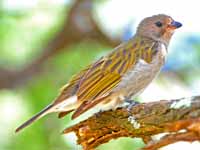
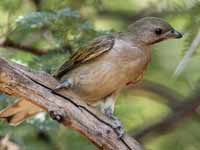
Honeyguide,_Malaysian Indicator archipelagicus
Description: The Malaysian honeyguide has olive-brown upperparts with greenish streaks, athick grey bill, andgreyish-white underparts. The male has a yellow patch on shoulder; female doesn't. The Malaysian honeyguide is 16 to 18 cm long.
Range: Indonesia (Borneo, Sumatra), Malaysia, Thailand.
Habitat: Broad-leafed forests.
Diet: Beeswax, insects.
Conservation status: It is listed as Near Threatened due to ongoing habitat loss, local and sparse population.
Image by: 1) Nicolas LeJeune Range: Indonesia (Borneo, Sumatra), Malaysia, Thailand.
Habitat: Broad-leafed forests.
Diet: Beeswax, insects.
Conservation status: It is listed as Near Threatened due to ongoing habitat loss, local and sparse population.
1) Male
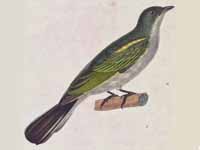
Honeyguide,_Pallid Indicator meliphilus
Description: The pallid honeyguide has olive upperparts,a grey-green head, white lores, and pale yellowish-grey underparts. It is about 13 cm long.
Range: Central Africa.
Habitat: Woodlands, forest edges.
Diet: Winged insects, beetles, beeswax. Captures prey on leaves, bark, on in the air.
Conservation status: Least Concern.
Image by: 1) Ken Clifton - TanzaniaRange: Central Africa.
Habitat: Woodlands, forest edges.
Diet: Winged insects, beetles, beeswax. Captures prey on leaves, bark, on in the air.
Conservation status: Least Concern.
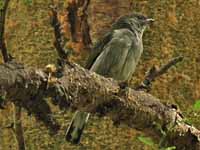
Honeyguide,_Scaly-throated Indicator variegatus Found: Africa
Description: The scaly-throated honeyguide has olive upperparts, The head, throat, and breast are grey and white-streaked with the throat and breast also having a scaly appearance. The belly is whitish with faint streaks. The scaly-throated honeyguide is 18 to 19 cm long.
Range: Middle and southern Africa, mostly on the eastern side.
Habitat: Woodlands, thickets, bamboo groves.
Diet: Beewax and related eggs plus larvae. Also ants, termites, beetles, caterpillars.
Conservation status: Least Concern.
Image by: 1) Nik Borrow - Zanbia 2) Steve Garvie 3) Peter_Steward - MalawiRange: Middle and southern Africa, mostly on the eastern side.
Habitat: Woodlands, thickets, bamboo groves.
Diet: Beewax and related eggs plus larvae. Also ants, termites, beetles, caterpillars.
Conservation status: Least Concern.
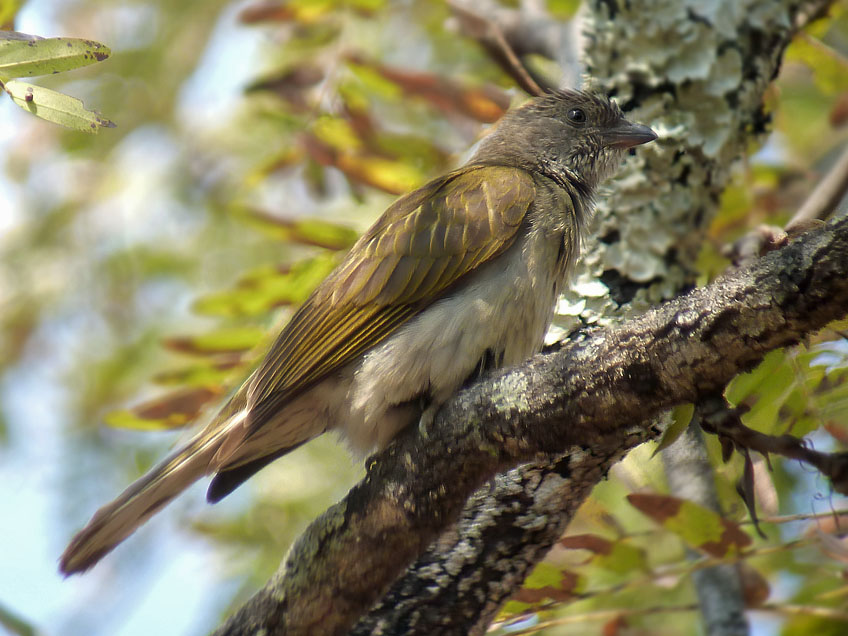
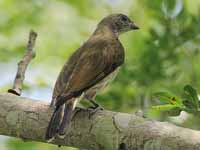
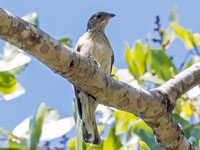
Honeyguide,_Spotted Indicator maculatus
Description: The spotted honeyguide has olive-green upperparts and a dark tail with white edges. The underparts are pale green with numerous white spots on the breast andless prominent spotting on the belly. The spotted honeyguide is 18 cm long.
Range: Central Africa.
Habitat: Forests including clearings and edges, areas reverting to forest.
Diet: Beeswax and related eggs plus larvae. Also ants, termites, insect larvae, beetles, caterpillars.
Conservation status: Least Concern.
Image by:
1)
Frans Vandewalle - Gambia Range: Central Africa.
Habitat: Forests including clearings and edges, areas reverting to forest.
Diet: Beeswax and related eggs plus larvae. Also ants, termites, insect larvae, beetles, caterpillars.
Conservation status: Least Concern.
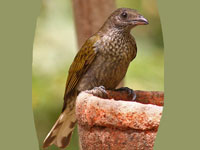
Honeyguide,_Thick-billed Indicator conirostris
Description: The thick-billed honeyguide has yellow-green upperparts with dark streaking. The head is dark grey with a small white loral area and black malar stripes. The underparts are pale grey and unmarked. The black tail has white edges. The thick-billed honeyguide is 14 to 15 inches long.
Range: Central Africa, not reaching to the east coast.
Habitat: Interior of dense forests.
Diet: Beeswax and related eggs plus larvae, bees. Also ants, other insects and their larvae, beetles, caterpillars. Also fruit. It is able to catch insects onthe fly.
Conservation status: Least Concern.
Image by: 1) Francesco_VeronesiRange: Central Africa, not reaching to the east coast.
Habitat: Interior of dense forests.
Diet: Beeswax and related eggs plus larvae, bees. Also ants, other insects and their larvae, beetles, caterpillars. Also fruit. It is able to catch insects onthe fly.
Conservation status: Least Concern.
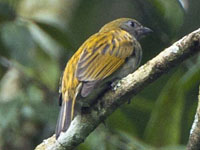
Honeyguide,_Willcocks's
Description: The Willcock's honeyguide has green upperparts with darker streaks. Its grey head is unmarked. The pale underparts have a few white streaks. It is a small honeyguide with a length of 12 to 13 cm.
Range: Central Africa.
Habitat: Primary forests, secondary forests especially with tall trees. Also more open areas with trees available.
Diet: Beeswax, insects. It can hawk flying insects.
Conservation status: Least Concern.
Image by: 1, 2) Nik_Borrow - SenegalRange: Central Africa.
Habitat: Primary forests, secondary forests especially with tall trees. Also more open areas with trees available.
Diet: Beeswax, insects. It can hawk flying insects.
Conservation status: Least Concern.
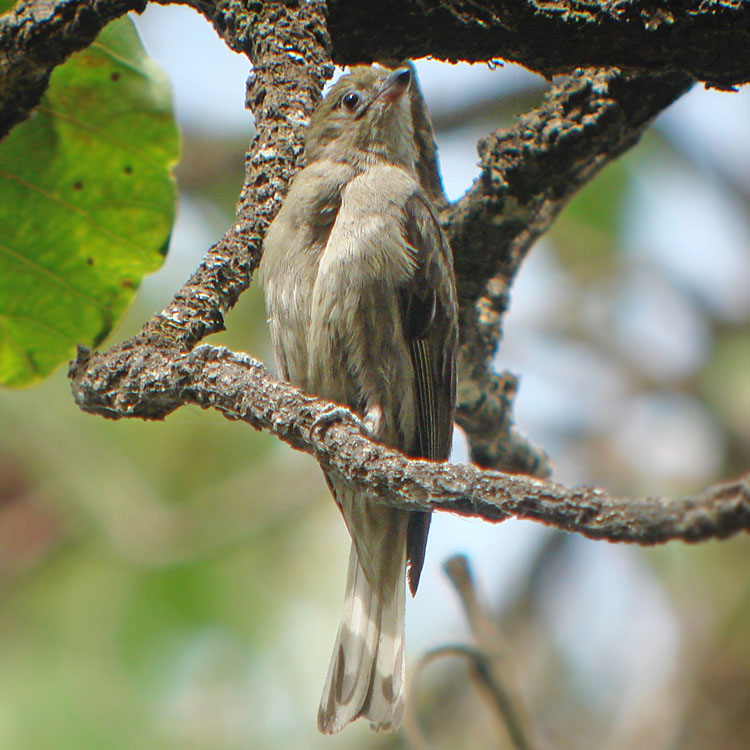

Honeyguide,_Yellow-rumped Indicator xanthonotus
Description: The yellow-rumped honeyguide has dusky olive upperparts. It has an orange forehead, lores, and rump which are definitive markings. Also, the chin is yellowish. The bill is yellow with a dark bill. The underparts are pale grey with dark streaks. The yellow-rumped honeyguide is 16 cm long.
Range: Asia, mainly in Himalayan foothills.
Habitat: Coniferous and dry-deciduous forest with rocky boulders and cliffs.
Diet: Beeswax, insects. It can hawk insects in flight.
Conservation status: It is listed as Near Threatened because of declining populations. More information is needed.
Image by: 1) R. E. B. 2, 3) Dibyendu_AshRange: Asia, mainly in Himalayan foothills.
Habitat: Coniferous and dry-deciduous forest with rocky boulders and cliffs.
Diet: Beeswax, insects. It can hawk insects in flight.
Conservation status: It is listed as Near Threatened because of declining populations. More information is needed.
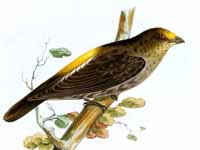
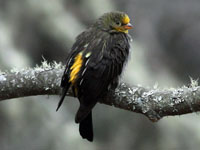

Genus Melichneutes - 1 species
Honeyguide,_Lyre-tailed Melichneutes robustus
Description: The lyre-tailed honeyguide has dark olive-brown upperparts including the head. The dark tail, which has white edges, can be spread at the end like a fan, especially for the male. It has whiitsh underparts with some dark streaking on the flanks. The lyre-tailed honeyguide is about 17 inches long.
Range: Central Africa.
Habitat: Tropical rainforests.
Diet: Beeswax, insects including termites. F\Also figs.
Conservation status: Least Concern.
Range: Central Africa.
Habitat: Tropical rainforests.
Diet: Beeswax, insects including termites. F\Also figs.
Conservation status: Least Concern.
Genus Melignomon
Honeyguide,_Yellow-footed Melignomon eisentrauti
Description: The yellow-footed honeyguide has olive-green upperparts including the head with the back being more yellowish than the head. It has a pale grey chin, throat, and underparts. The legs plus feet are yellow and the bill is yellowish. The yellow-footed honeyguide is about 14 cm long.
Range: West Africa:Sierra Leone, Liberia, Guinea, Ghana, Ivory Coast, Nigeria and Cameroon.
Habitat: Lowland forests, secondary forest.
Diet: Beeswax, insects, fruits and seeds.
Conservation status: It is listed as Near Threatened because of forest removal or degradation.
Image by: 1, 2) Nik_BorrowRange: West Africa:Sierra Leone, Liberia, Guinea, Ghana, Ivory Coast, Nigeria and Cameroon.
Habitat: Lowland forests, secondary forest.
Diet: Beeswax, insects, fruits and seeds.
Conservation status: It is listed as Near Threatened because of forest removal or degradation.
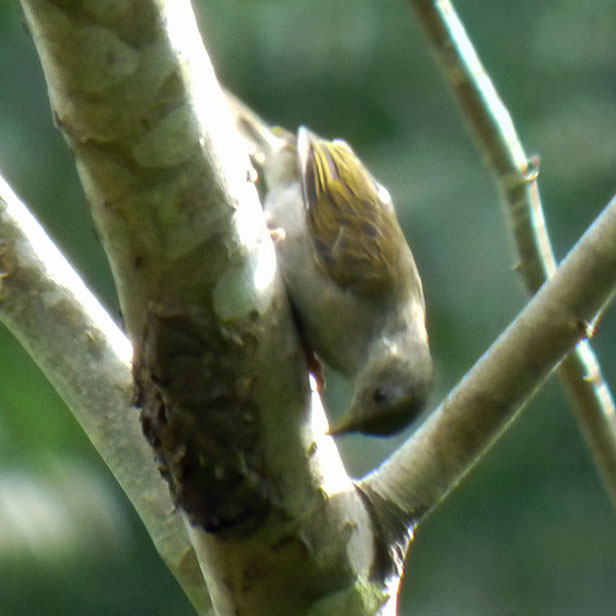
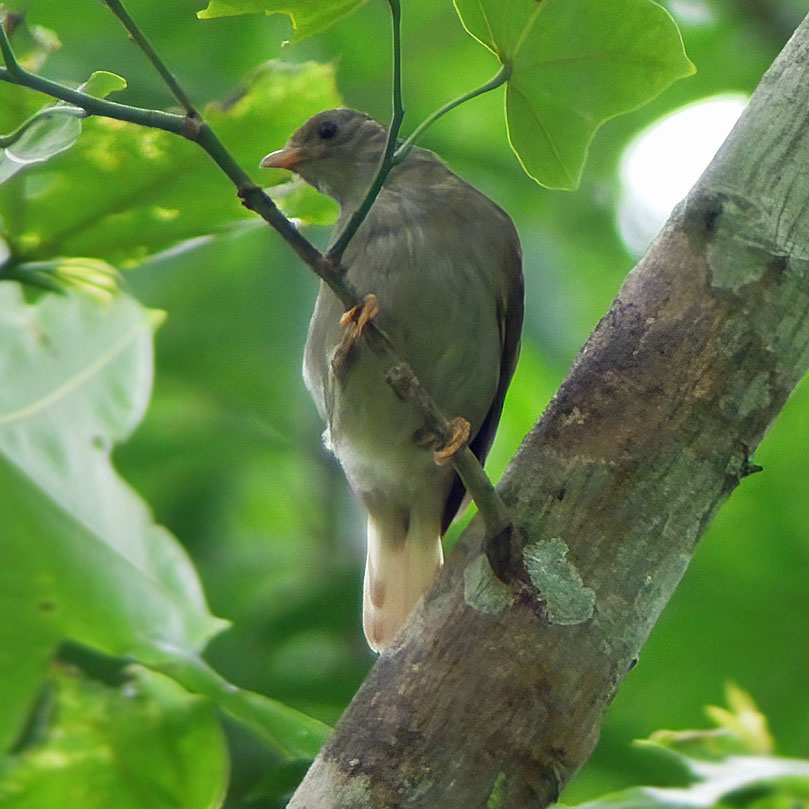
Honeyguide,_Zenker's Melignomon zenkeri
Description: The Zenker's honeyguide has olive upperparts with a darker head. The underparts are paler grey with yellow tinges. It is about 14 cm long.
Range: Central Africa.
Habitat: Forests, open land as long some trees are available.
Diet: Insects and probably beeswax.
Conservation status: It is listed as Least Concern, but it is rarely seen so perhaps the status should be degraded.
Range: Central Africa.
Habitat: Forests, open land as long some trees are available.
Diet: Insects and probably beeswax.
Conservation status: It is listed as Least Concern, but it is rarely seen so perhaps the status should be degraded.
Genus Prodotiscus
These African honeybirds have greyish upperparts, whitish-grey underparts, and small flycatcher-like bills. They are among the smallest of the honeyguides. They are called honeyguides as they belong to the honeyguide family Indicatoridae, but they are also called honeybirds as they probably do not eat beeswax. They often catch flying insects in the air like a flycatcher.
Honeybird,_Brown-backed Prodotiscus regulus
Description: The brown-backed honeybird, also known as the Wahlberg's honeyguide, has grey-brown upperparts, a thin black bill, and whitish underparts. The brown-backed honeybird is about 13 cm long.
Range: Southern Africa.
Habitat: Woodland and also grassland.
Diet: Insect larvae, insects especially waxy ones. Can capture insects in the air. Probably does not eat beeswax.
Conservation status: Least Concern.
Image by: 1, 2, 3) Alan Manson 4) Peter_StewardRange: Southern Africa.
Habitat: Woodland and also grassland.
Diet: Insect larvae, insects especially waxy ones. Can capture insects in the air. Probably does not eat beeswax.
Conservation status: Least Concern.
1) Juvenile 2) Juvenile with host parent Rock-loving Cisticola
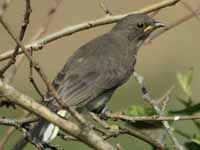
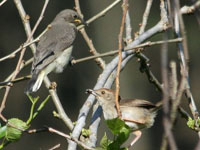
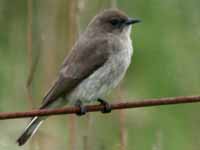
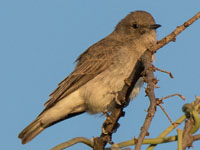
Honeybird, Cassin's Prodotiscus insignis
Description: The Cassin's honeybird, also known as the Cassin's honeyguide, has green upperparts with yellow edges to flight feathers. It is about 10 cm long.
Range: Central Africa.
Habitat: Primary and secondary forests plus their clearings and edges. More open areas with trees nearby.
Diet: Insect larvae, insects especially waxy ones. Can capture insects in the air. Probably does not eat beeswax.
Conservation status: Least Concern.
Image by: 1, 2) Nik_Borrow - UgandaRange: Central Africa.
Habitat: Primary and secondary forests plus their clearings and edges. More open areas with trees nearby.
Diet: Insect larvae, insects especially waxy ones. Can capture insects in the air. Probably does not eat beeswax.
Conservation status: Least Concern.
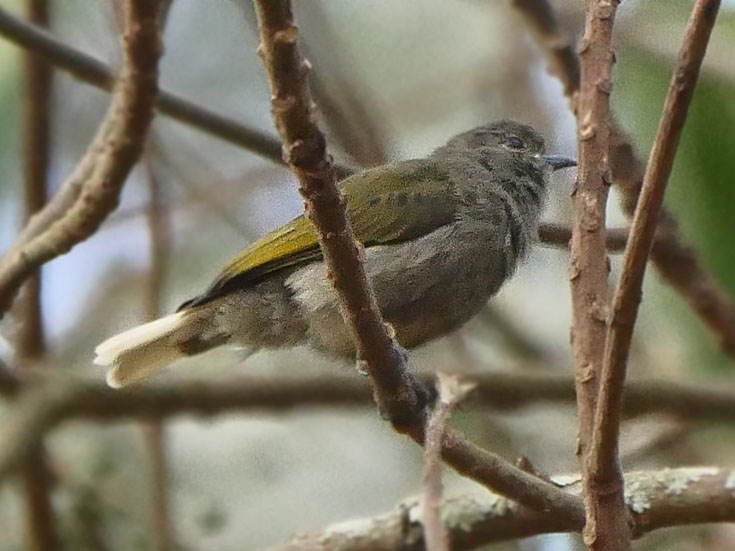
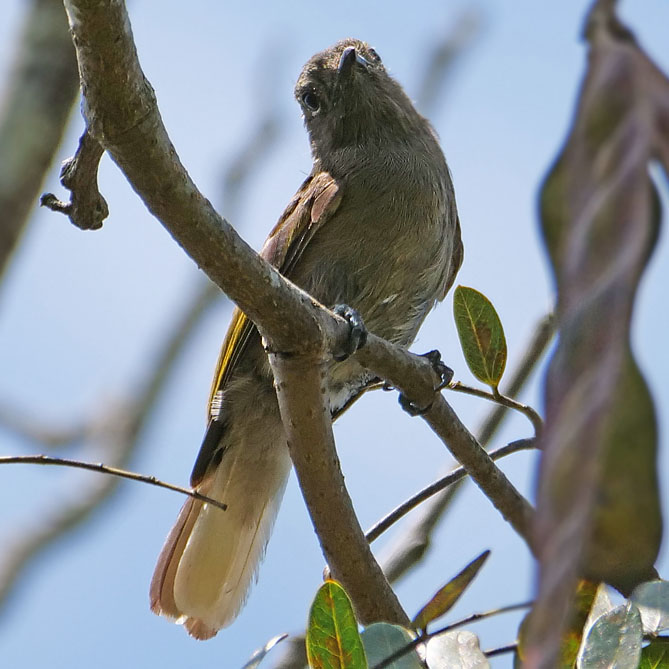
Honeybird,_Green-backed Prodotiscus zambesiae
Description: The green-backed honeybird, also known as the green-backed honeyguide, has green upperparts. The underparts are grey-white withthe belly mainly white. It is 11 cm long.
Range: South-central Africa: Angola, Botswana, DR Congo, Kenya, Malawi, Mozambique, Namibia, Tanzania, Zambia, Zimbabwe.
Habitat: Forests, degraded forests, gardens.
Diet: Insect larvae, insects especially waxy ones. Can capture insects in the air. Probably does not eat beeswax.
Conservation status: Least Concern.
Image by: 1) Nik_Borrow - Ethiopia 2) Maans_Booysen - AngolaRange: South-central Africa: Angola, Botswana, DR Congo, Kenya, Malawi, Mozambique, Namibia, Tanzania, Zambia, Zimbabwe.
Habitat: Forests, degraded forests, gardens.
Diet: Insect larvae, insects especially waxy ones. Can capture insects in the air. Probably does not eat beeswax.
Conservation status: Least Concern.
